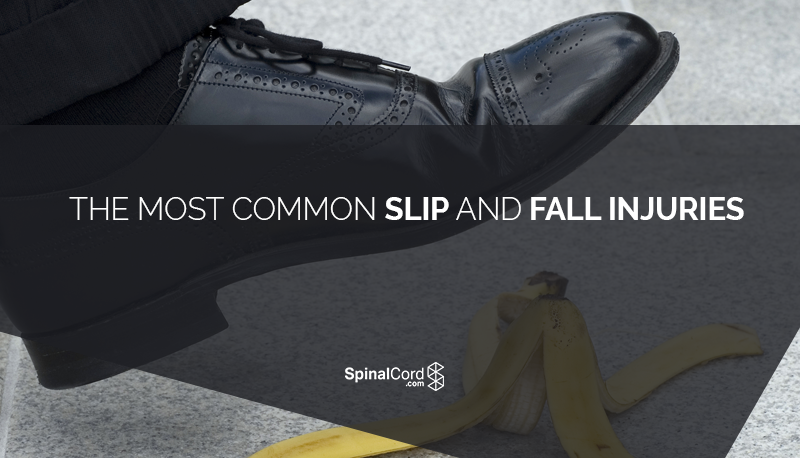The Most Common Slip and Fall Injuries

A slip and fall can change your day, your week, and maybe even your life. These injuries, which can happen anywhere and to anyone, are frightening in their suddenness. They can also be quite painful, potentially producing millions of dollars in medical bills and lost wages.
Slip and falls are the most common variety of accidental injuries, aside from auto accidents, that personal injury lawyers litigate. But a slip and fall is only a cause, not a type, of injury. So what are the most common types of slip and falls? They range from minor to severe, and even deadly.
Types of Slip and Fall Injuries
Soft Tissue Injuries
Soft tissue injuries aren't outwardly visible, which can make them difficult to prove in a lawsuit. You might not even realize that you have a soft tissue injury until days, or even weeks, after the initial fall. Soft tissue injuries range from minor ankle and wrist sprains to devastating tears in tendons and ligaments.
Left untreated, soft tissue injuries can cause chronic pain, and may also make you more vulnerable to subsequent injuries. Even if you feel fine after a fall, it's important to seek medical care, since soft tissue injuries don't often produce immediate symptoms.
Head Injuries
Even an apparently minor head injury is a medical emergency. If you fall and hit your head—especially if there is swelling, bleeding, or even a brief loss of consciousness—you need immediate medical care. Minor concussions usually clear up on their own, but more serious traumatic brain injuries (TBI) can permanently alter your ability to function. Head injuries cannot be diagnosed based on symptoms alone, and some very serious head injuries produce only minimal symptoms at first. No matter how inconvenient it is or how “fine” you feel, your first stop after a head injury should be to your doctor. This can also increase your odds of a successful lawsuit, since a medical visit provides firm documentation of your injury.
Cuts and Abrasions
Slip and falls that produce cuts and abrasions can look quite severe, but the injuries are often less extensive than other sorts of slip and falls. Leg and arm abrasions are common, as are wounds to the head and hips. In most cases, these injuries only require superficial treatment, and perhaps some stitches. But if the impact of the fall is sufficiently hefty, cuts and abrasions may rest atop more serious injuries, such as concussions and broken bones.
Spinal Cord Injuries
Spinal cord injuries occur when the spinal cord is either severed or compressed. These injuries are almost always life-threatening, and demand immediate medical care, as well as ongoing treatment. They are among the most costly injuries to treat, costing up to a million dollars or more in the first year after the spinal injury.
Generally speaking, the higher up in the spinal cord the injury is located, the more extensive the damage will be. High cervical spinal cord injuries often produce quadriplegia -- full paralysis -- while injuries lower in the spinal cord may only produce paraplegia -- paralysis of the lower limbs; or potentially even milder symptoms.
Broken Bones
Broken bones are painful, scary, and can range from only minor fractures to severe breaks demanding numerous surgeries. The tissue surrounding broken bones may also be damaged, necessitating long-term therapy to prevent chronic pain and neuromuscular dysfunction.
Though a popular myth suggests that a bone is not broken if you can move the joint, it is impossible to diagnose a broken bone without an X-ray. If you take a sudden, sharp fall and feel concentrated pain in a bone or joint, go to an emergency room.
Because broken bones can cause extensive bleeding, and because the swelling that occurs over the first 12 hours can make the break more difficult to treat, prompt medical intervention is vital for your recovery.
Common Causes of Slip and Falls
Though it is possible to sustain a slip and fall injury through your own negligence, most slip and fall cases are due at least in part to negligence on the part of the business. Some of the most common causes of slip and falls include:
- Debris on the floor, such as fruit spilled at a grocery store.
- A floor that is excessively wet, without appropriate warning, such as might occur after waxing a linoleum floor.
- Uneven surfaces, such as a hole or indentation in a concrete floor.
- Unsafe construction or working zones, including failure of workers to take proper precautions, or failure of managers to either allow or instruct workers to take proper precautions.
If you suspect that you or someone you love sustained a slip and fall injury as a result of someone else’s negligence, you should talk to a lawyer immediately to see if you have a case. Lawsuits for slip and fall injuries have statutes of limitations that vary by state; which means you have a limited timeframe in which you can legally file a lawsuit.
Call us at 877-336-7192 or click the live chat button to talk to a personal injury legal expert right now to learn more about the legal potential of your case.
Stay Updated on Advancements On Traumatic Brain &
Spinal Cord Injuries
About the Author





